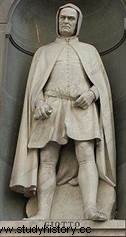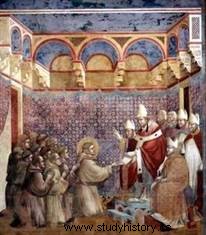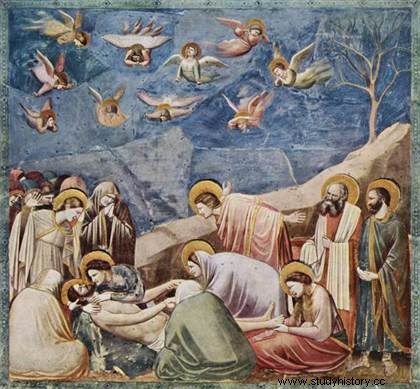 Giotto di Bondone or Ambrogiotto di Bondone (1267-1337) was an Italian painter, sculptor and architect of the Trecento (14th century). He is considered the creator of the pictorial language of the Renaissance, inspiring his work from the nascent humanism at the end of the Middle Ages. Giotto worked mainly in Rome, Milan, Rimini and Florence, and influenced many Renaissance artists, including those of the Rimini school. Renaissance artists would use his research to develop painting and represent subjects in a more lively and realistic way. Giotto is also the architect of the campanile of Florence Cathedral (1334). Vasari said of him:"He was the one who revived the art of painting, forgotten for so many years".
Giotto di Bondone or Ambrogiotto di Bondone (1267-1337) was an Italian painter, sculptor and architect of the Trecento (14th century). He is considered the creator of the pictorial language of the Renaissance, inspiring his work from the nascent humanism at the end of the Middle Ages. Giotto worked mainly in Rome, Milan, Rimini and Florence, and influenced many Renaissance artists, including those of the Rimini school. Renaissance artists would use his research to develop painting and represent subjects in a more lively and realistic way. Giotto is also the architect of the campanile of Florence Cathedral (1334). Vasari said of him:"He was the one who revived the art of painting, forgotten for so many years".
The life of Giotto di Bondone
Giotto was probably born in 1267, in Vespignano or Romignano, in Tuscany. He comes from a peasant family, but we know very little about his youth. Legend - as reported by Giorgio Vasari in his Vite - has it that the Tuscan painter Cimabue met Giotto when the young boy, while tending his flock, "drew a sheep from life on a flat, polished stone, using a slightly pointed stone, with no other master than nature”. Although no document attests to it, it is very likely that the young Giotto accompanied Cimabue who, no doubt having become his master around 1280, brought him to the site of the Basilica of San Francesco in Assisi where he was commissioned to carry out several cycles of frescoes.
 He worked during the 1290s in the upper church of the Basilica of Assisi and painted pictures for the churches in Florence, such as the "Crucifix" of Santa Maria Novella. Giotto travels a lot during his career. Besides his great achievements in Assisi and Padua, he also traveled to Rome, Pisa, Rimini, Florence, the Kingdom of Naples, etc. In 1300, he was in Rome where he began to acquire his reputation in the pontifical construction sites.
He worked during the 1290s in the upper church of the Basilica of Assisi and painted pictures for the churches in Florence, such as the "Crucifix" of Santa Maria Novella. Giotto travels a lot during his career. Besides his great achievements in Assisi and Padua, he also traveled to Rome, Pisa, Rimini, Florence, the Kingdom of Naples, etc. In 1300, he was in Rome where he began to acquire his reputation in the pontifical construction sites.
At the beginning of the 14th century, he was in Padua, where he worked on the Scrovegni chapel (from 1304 to 1312), and his reputation was already great; he is requested in Milan (where he works for the Visconti), in Rimini or Naples (at the court of Robert of Anjou). Giotto was then a court artist, directing the palace painting teams; in addition, he received a number of privileges that allowed him to found his own workshop, where he trained apprentices, including Taddeo Gaddi.
After his stay in Naples, Giotto returned to Florence one last time to direct architectural works there, including the construction of the bell tower of Santa Maria del Fiore. Started in 1334, the construction of the famous campanile was interrupted three years later by the death of the artist who was only able to build the base of the building. The building was finally completed by the architects Andrea Pisano and Francesco Talenti. Giotto was honored by Florence on April 12, 1334, he received the title of master builder of the city's cathedral. He died in 1337, and is buried with pomp in the cathedral where he worked, proof of his impact on the arts and the princes during his lifetime.
Giotto's work and style
Giotto's work is a break with the Byzantine influence of painters from Siena like Cimabue, who is said to have introduced the young Giotto, then a shepherd, to the arts . Giotto is distinguished by a figurative naturalism that revolutionizes the painting of his time, giving this art clear and legible narrative principles, without equivalent before him. We also note his use of perspective which gives his works a very realistic spatial depth.
Turning away from the Byzantine influence, the painter explores a new way of representing space and introduces into his works a sense of the real, of the living, completely new. Endowed with a solid narrative talent, he stages the action in a carefully constructed setting, using in particular the use of architectural structures. Thus his art impresses by the feeling of harmony and balance that emerges but also by the evocative power that inhabits it.
 Giotto also offers a resolutely innovative vision of man. Perfectly individualized in their attitudes, their costumes and their expressions, his characters possess a monumental character which testifies to the influence of sculpture, and in particular of the works of Nicola Pisano and Arnolfo di Cambio. This desire to give a plastic dimension to his representations is further reinforced by his treatment of shadows and color which reinforces and unifies the space of the representation. Driven by a great desire for naturalism, the painter also pays particular attention to the description of vegetation and animals. Thanks to Giotto, painting is no longer the reflection of an idealized and stereotyped vision; it draws its models from real life.
Giotto also offers a resolutely innovative vision of man. Perfectly individualized in their attitudes, their costumes and their expressions, his characters possess a monumental character which testifies to the influence of sculpture, and in particular of the works of Nicola Pisano and Arnolfo di Cambio. This desire to give a plastic dimension to his representations is further reinforced by his treatment of shadows and color which reinforces and unifies the space of the representation. Driven by a great desire for naturalism, the painter also pays particular attention to the description of vegetation and animals. Thanks to Giotto, painting is no longer the reflection of an idealized and stereotyped vision; it draws its models from real life.
However, few works by Giotto remain from this period, his reputation being made by his disciples and successors, in Florence and Rimini, then in the 16th century with Vasari. We can still admire his frescoes painted in Florence, Padua and Assisi, those of Milan and Naples having disappeared.
Giotto is an artist who allows us to see both the revival of painting in this Pre-Renaissance, and the relationship between the artist and the patron, prince or ecclesiastic.
Bibliography
- E. Crouzet-Pavan, Hell and Paradise. The Italy of Dante and Giotto, 490 pages, Albin Michel, 2004.
- F. Flores d'Arcais, Giotto, Actes Sud/Motta, 2001.
- Giotto and the Humanists, by Michael Baxandall. History Points, 2016.
